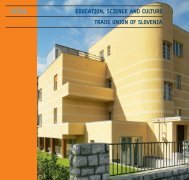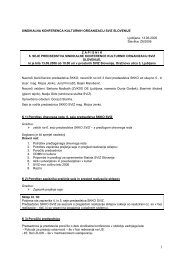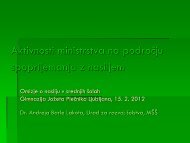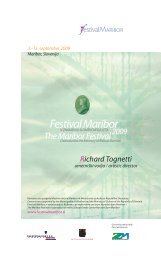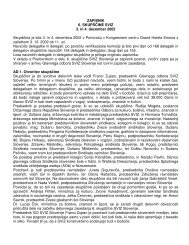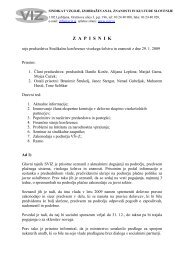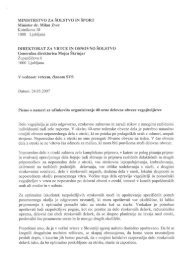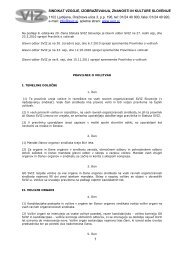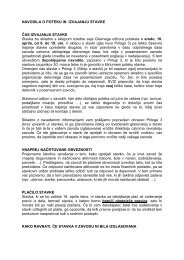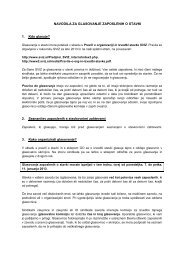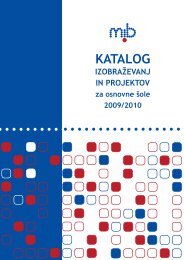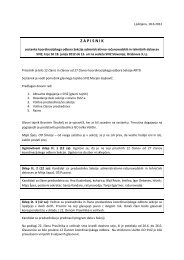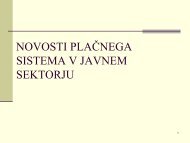The use and misuse of teacher appraisal - Education International
The use and misuse of teacher appraisal - Education International
The use and misuse of teacher appraisal - Education International
Create successful ePaper yourself
Turn your PDF publications into a flip-book with our unique Google optimized e-Paper software.
T H E U S E A N D M I S U S E O F T E A C H E R A P P R A I S A L<br />
3.2. Comprehensive approaches<br />
In contrast with VAMs, comprehensive methods for <strong>teacher</strong> evaluation are gaining<br />
recognition. <strong>The</strong>y take into account multiple factors associated with teaching, <strong>and</strong> are<br />
more foc<strong>use</strong>d on <strong>teacher</strong>s <strong>and</strong> their development.<br />
First <strong>of</strong> all, these methods are based on a shared consensus on the involvement <strong>of</strong> <strong>teacher</strong>s<br />
throughout the development <strong>of</strong> the process (Isore, 2009). In the US districts that <strong>use</strong><br />
Peer Assistance <strong>and</strong> Review (PAR) programmes, highly expert mentor <strong>teacher</strong>s<br />
conduct some aspects <strong>of</strong> the evaluation <strong>and</strong> provide assistance to <strong>teacher</strong>s in need (Strauss,<br />
2012; Newton et al, 2010). New York State’s TED is another practitioner-developed<br />
instrument (Box 4), where <strong>teacher</strong>s both devise <strong>and</strong> participate in their own evaluation.<br />
Key features <strong>of</strong> these systems encompass instruments <strong>use</strong>d for evaluation together with<br />
the expertise <strong>of</strong> the consulting <strong>teacher</strong>s or mentors – skilled <strong>teacher</strong>s in the same subject<br />
areas <strong>and</strong> school levels who have been given time to serve as mentors to support their<br />
fellow <strong>teacher</strong>s – <strong>and</strong> a system <strong>of</strong> due process <strong>and</strong> review involving a panel <strong>of</strong> both<br />
<strong>teacher</strong>s <strong>and</strong> administrators in making recommendations. Many systems using this approach<br />
have been found to improve teaching <strong>and</strong> to successfully identify <strong>teacher</strong>s for<br />
continuation <strong>and</strong> tenure as well as intensive assistance <strong>and</strong> personnel action.<br />
Secondly, comprehensive methods such as TED, among others, are developed on the<br />
basis <strong>of</strong> pr<strong>of</strong>essional st<strong>and</strong>ards that have been translated into <strong>teacher</strong> evaluation<br />
instruments (Box 4). <strong>The</strong>y incorporate classroom evidence <strong>of</strong> student learning <strong>and</strong> they<br />
have recently been shown in larger-scale studies to predict <strong>teacher</strong>s’ value-added<br />
effectiveness. In short, they help ground evaluation in student learning in more stable<br />
ways compared to other systems <strong>of</strong> <strong>teacher</strong> <strong>appraisal</strong>. In many schools <strong>and</strong> districts,<br />
assessments <strong>of</strong> <strong>teacher</strong>s are based on well-articulated st<strong>and</strong>ards <strong>of</strong> practice evaluated<br />
through evidence that includes observations <strong>of</strong> teaching along with <strong>teacher</strong> interviews<br />
<strong>and</strong>, sometimes, other elements such as lesson plans, assignments, <strong>and</strong> samples <strong>of</strong> student<br />
work (Strauss, 2011; Newton et al, 2010).<br />
<strong>The</strong> Gates Foundation has launched a major initiative to find additional tools validated<br />
against student achievement gains, which can be <strong>use</strong>d in <strong>teacher</strong> evaluation at the local<br />
level. <strong>The</strong> Measure <strong>of</strong> Effective Teaching (MET) Project has developed a number <strong>of</strong><br />
instruments based on the st<strong>and</strong>ards-based assessments described above <strong>and</strong> new ones<br />
such as observations or videotapes <strong>of</strong> <strong>teacher</strong>s, supplemented with other items <strong>of</strong> practice<br />
(lesson plans, assignments, etc.), which can be scored according to a set <strong>of</strong> st<strong>and</strong>ards<br />
which reflect practices associated with effective teaching (Strauss, 2011; Newton et<br />
al, 2010). Instruments also include student surveys about teaching practice, significantly<br />
related to student achievement gains.<br />
Teacher collaboration can also be a key factor in <strong>teacher</strong> <strong>appraisal</strong>. Countries such as<br />
Singapore, for instance, put a great emphasis on such collaboration in their evaluation<br />
45



